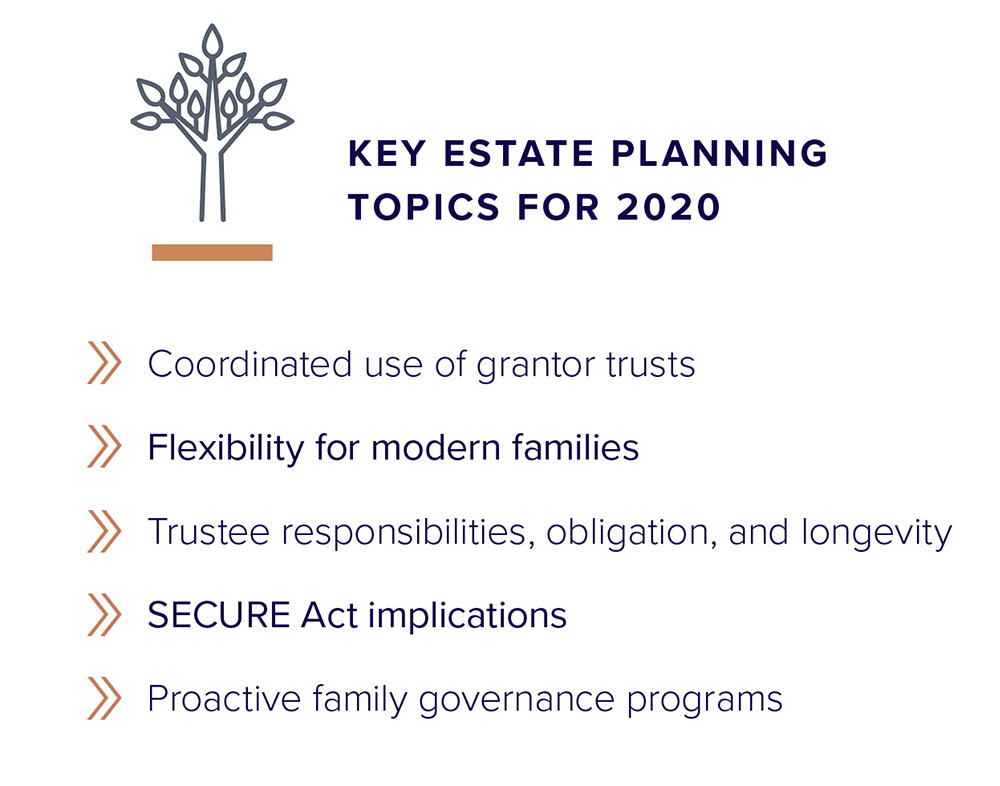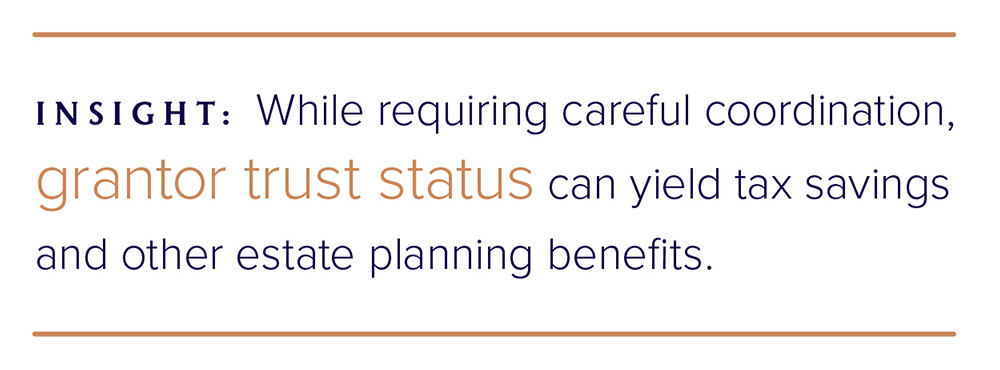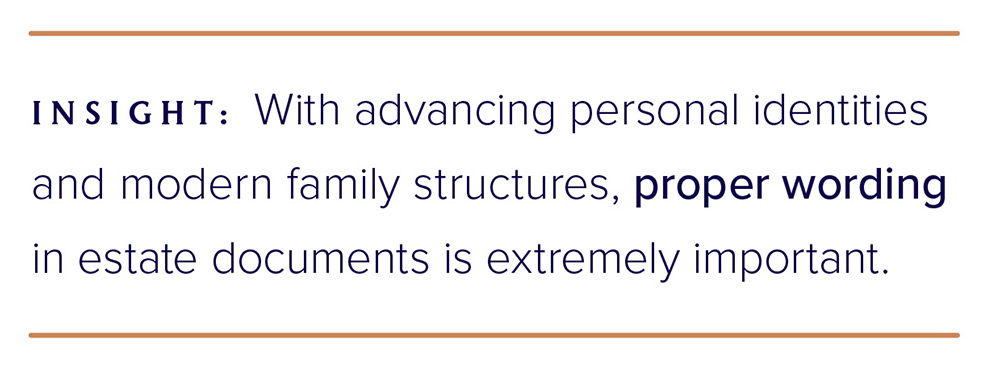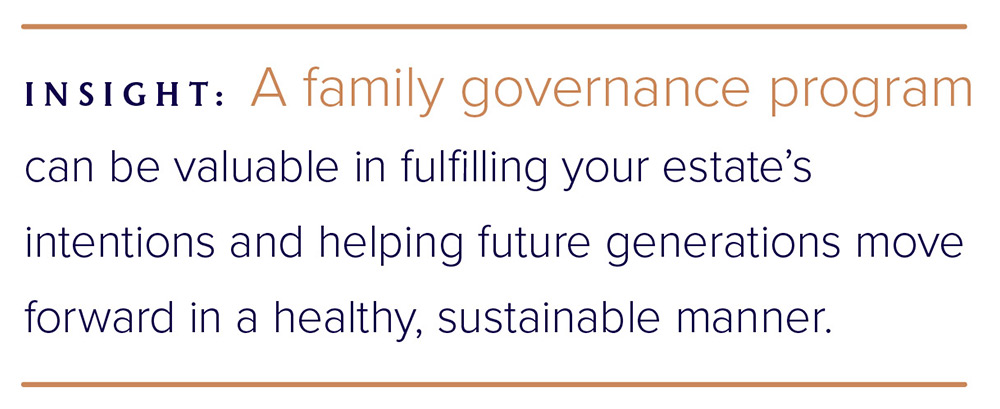The Heckerling Institute on Estate Planning, hosted by the University of Miami Law School, is widely considered to be the nation’s premier conference on estate planning. A few weeks ago in January, Justin Sanderson (Vice President and Chief Compliance Officer) and I joined many of the industry’s best minds at the 54th annual conference in Orlando, Florida. We were two of only a handful of Western New York wealth management professionals in attendance.
At the conference, we heard from well-known thought leaders in the field of estate planning, as well as some up-and-coming voices. Both offered their fresh perspectives on traditional estate planning topics, as well as new, cutting-edge planning considerations and techniques.
This year’s core topics included the recently passed SECURE Act legislation, the fundamentals of grantor trusts and insurance products, trustee liability considerations, and charitable planning ideas.
Some of the more progressive topics included planning for non-traditional families (including LGBTQ considerations, non-biological children, and atypical family planning situations), a discussion on the elements of financial warfare in geopolitics, and planning for the disposition of digital assets.
We came away with several bright ideas, as well as plenty of validation for strategies that we’ve been using with our clients since we began practicing. Here are a few of our favorite takeaways from this year’s conference.

The coordinated use of grantor trusts in estate planning.
Trusts are a central and powerful component of many sophisticated estate plans. The coordinated use of grantor and non-grantor trusts can enable estate planners to shift the taxation of income from grantors, to trusts, to beneficiaries, and even to other third parties, in order to achieve planning objectives. Leveraging the lower marginal tax rates of each of these parties is a key aspect of efficient tax planning for multi-generational families.
Additionally, to achieve estate tax savings, “tax burn” strategies (where a grantor with a taxable estate uses their personal assets to pay taxes on income generated by assets already transferred out of their estate) can be a very powerful planning technique. Income and estate tax planning strategies require careful coordination of grantor/non-grantor trust status.
Certain powers retained by a grantor that can be used to intentionally trigger grantor trust status, such as the power of substitution (i.e., swap powers), can also present planning opportunities around income taxes and tax basis adjustments. For example, a grantor exchanging low-basis assets inside a trust for high-basis assets (i.e., cash) held outside of the trust can yield significant income tax savings for heirs if the low-basis assets receive a step-up in basis at the death of the grantor.

Proper planning to achieve and maintain (if desired) grantor trust status is vital to the long-term success of many estate plans, and on-going monitoring is essential to achieving wealth planning objectives.
Drafting estate plans with flexibility for modern families.
Most traditional wills and trusts have been written without contemplating the evolution of the modern family and without foresight for medical advancements in family planning. For instance, traditional references to “son” and “daughter” have suddenly become ambiguous with advancements in the area of gender personal identification and reassignment procedures. Additionally, medical advancements in IVF have caused estate planning complexities for children being conceived after the death of a biological parent and at out-of-sequence times compare to societal norms.

For families with current elements of these modern complexities, proper wording in their estate plan documents is extremely important to ensure their objectives are met. Families engaging in multi-generational estate planning should do so with the understanding that their children, grandchildren, and perhaps generations beyond them may experience some of these changing definitions of family and self-identity, along with medical advancements that seem improbable today.
Lauren J. Wolven, a partner in the Trusts & Estates Group at the law firm Levenfeld Pearlstein, LLC, lead the conference presentation on how modern and future families will look and be created differently. She shared a great resource from GLAAD about acceptable references to members of the LGBTQ community in the media, which may also be applied to our estate documents.
Trustee responsibilities, obligations, and longevity.
Being named a trustee, almost by definition, should be considered an honor. However, with this great honor comes great responsibility. The ramifications of a trustee breaching their fiduciary obligations to beneficiaries can be severe. While most people accept the role of being a trustee without hesitation or apprehension, many don’t understand what is expected and required of them throughout their time serving in this capacity.
While governed specifically by state statute, generally trustees have a responsibility to ensure the prudent oversight and management of trust assets and investments, that trust assets and transactions are accurately accounted for and the appropriate records are retained, and that beneficiaries are informed regarding the existence and activities of the trust, to the extent necessary and required. Additionally, trustees have the responsibility of making sure that the distributive provisions and standards of the trust are properly followed.
On top of the time-consuming task of carrying out their responsibilities, trustees can be pressured by settlors to hide the existence of trusts from beneficiaries, to manage and invest trust assets in accordance with their personal investment philosophy, and to make distributions in accordance with their wishes. A trustee caving to these pressures can amount to a breach of their fiduciary obligation to the current and/or remainder beneficiaries of the trust. Depending on perceived and actual damages resulting from this, the trustee can be held personally liable, sometimes regardless of exculpation clauses included in the trust agreement.
It is vitally important that trustees understand what is expected and required of them when serving in the role. Depending on the scope of their responsibilities and experience, trustees (and perhaps settlors when creating trusts) are often encouraged to seek professional assistance to administer the trust, especially in states with Delegated or Directed Trust statues.
The power for future generations of beneficiaries and Trust Protectors to change trustees can provide important flexibility to ensure a trust is properly managed throughout its existence. A settlor often has great intentions when creating an initial list of trustees. However, as time goes by, family dynamics change and corporate trustees close, merge, and move, making it difficult to maintain the settlor’s intent and keep the beneficiaries happy. Giving beneficiaries and Trust Protectors the ability to change trustees to adapt to this evolution can be vital to the long-term success of the estate plan.
SECURE Act estate planning implications.
The SECURE Act was passed by Congress on December 19, 2019, with provisions effective starting January 1, 2020. At the time of the conference, the details of the Act were still being digested. There was a sense that answers to many of the nuanced fact patterns questions will remain ambiguous until regulations are put in place by the IRS.
The general impact on high-net-worth individuals and estate plans, however, was relatively clear. Many require the immediate attention of wealth management professionals and estate planners. The following were some key changes and considerations.
- The Act allows individuals to continue to contribute to Individual Retirement Accounts (IRAs) after reaching age 70 ½. However, the requirement that the individual has sufficient earned income to allow them to contribute to an IRA remains in place.
- The required minimum distribution age has been extended from 70 ½ to 72. This provision is effective for individuals who turn 70 ½ after December 31, 2019. It will allow individuals to keep assets in their retirement accounts growing tax deferred for a slightly longer time period than before. While only a minor adjustment, every little bit extra in the world of tax deferral helps!
- Effective for deaths of plan participants or IRA owners beginning in 2020, the traditional “stretch provision” of IRAs, which generally allowed individual beneficiaries to take minimum required distributions from their inherited IRA out over their remaining life expectancy, has been changed. Distributions to non-spouse beneficiaries must be sufficient to fully distribute the inherited account within 10 years following the original owner’s death. A deceased owner’s spouse, minor child (until reaching the age of majority), or a disabled or chronically-ill individual beneficiary will still be able stretch inherited IRA distributions over their remaining life expectancy, along with any other individual who is not more than 10 years younger than the owner.
The elimination of the stretch provision for most non-spouse beneficiaries should prompt anyone who has incorporated IRA conduit trusts in their estate plan to revisit their documents to ensure their objectives are still being met.
Prior to the SECURE Act, trustees of conduit trusts were generally tasked with passing along RMDs to individual beneficiaries over their remaining life expectancy, while preserving the corpus of the IRA held inside of the trust. Now, with technically no RMDs required other than one large one liquidating the IRA at the end of the 10th year, there is no steady stream of distributions required to the conduit trust beneficiaries and no assurance that the assets will be preserved and protected for their lifetime.

While some of the provisions of the SECURE Act take away popular planning techniques, opportunities still exist to manage the taxation and protection of IRA assets. Charitable remainder unitrusts (CRUTs) may see a resurgence as a technique to stretch an IRA over a non-spouse beneficiary’s lifetime (with the caveat of the remainder going to charity at their death). Additionally, managing income taxation during the account owner’s lifetime via strategic draws and Roth conversions will become increasingly important, as will tax planning for non-spouse beneficiaries during their 10-year distribution window.
Proactive family governance programs.
For most wealthy matriarchs and patriarchs, ensuring that family wealth is stewarded for future generations is a central concern. However, equally as important to them is multi-generational family harmony, a sense of purpose and achieving a legacy, along with the personal productivity and motivation of each family member. A well-thought family governance program is often central to achieving success in these areas, especially where significant family wealth is already evident, or perhaps even already impacting, multiple generations and members of the family.
Generally, low-income and middle-income family members tend to develop inter-dependence with each other. This is caused by their fiscal constraints and the need to coordinate, communicate and, compromise with each other in order to survive and achieve their personal and family goals. First-generation wealth is often born from these situations and it’s through these lessons, along with their hard work, ingenuity, and dedication, that they build businesses and multi-generational wealth.
Coming from a place of love and good intentions, the first generation often tries to provide a sense of financial independence for their children, without financial hardships or constraints. However, with the sense of independence comes the ability for their children to disconnect and limit communication with each other, the elimination of the need for compromise, and a focus on selfish needs and wants. This is exactly what the first-generation wealth creators do not want for their families, particularly when it deteriorates into a cycle of financial dependency and non-productivity for the third generation and beyond.

A family governance program can be instrumental in ensuring future generations move toward and maintain a healthy combination of independence and inter-dependence with each other in order to continue the family’s financial and personal success for generations. These family governance programs can be built around a family’s philanthropic efforts, business endeavors or management of investments. It should include family meetings where family members can communicate with each other, listen, compromise and work together on any of these efforts, all while instilling the values and interpersonal skills that can otherwise be easily lost while living in an environment of significant family wealth.
Going a step further, first-generation wealth creators can even prefund the family governance program for future generations using trusts. This ensures that future generations are enticed to attend and participate in these meetings, which can be at attractive venues in desirable locations with lovely amenities and food.
Putting these insights into action.
Once again, the Heckerling conference did not disappoint! Spending the week listening to world-class speakers, discussing forward-thinking ideas with each other, and applying those thoughts and ideas to our client’s individual situations hopefully exemplifies our commitment to service and to our firmwide value of continuous professional improvement. Our personalized approach to wealth management, proactive relationships, and limited client-to-advisor ratios enable us to keep all of our clients top-of-mind when thinking about the application of these planning opportunities.
We are already looking forward to Heckerling 2021 for more ways to help our clients achieve their wealth management and estate planning goals!
Disclosure
© 2020 Sanderson Wealth Management LLC. This information is not intended to be and should not be treated as legal, investment, accounting or tax advice and is for informational purposes only. Readers, including professionals, should under no circumstances rely upon this information as a substitute for their own research or for obtaining specific legal, accounting, or tax advice from their own counsel. All information discussed herein is current as of the date appearing in this material and is subject to change at any time without notice. Opinions expressed are those of the author, do not necessarily reflect the opinions of Sanderson Wealth Management, and are subject to change without notice. The information has been obtained from sources believed to be reliable, but its accuracy and interpretation are not guaranteed.
Let’s talk about your future.
Schedule a consultation to learn more about our investment services.
Filter Blog Posts
SUBJECT
- Investment Consulting (158)
- Financial Planning (142)
- Tax Consulting (44)
- Estate & Generational Wealth Planning (15)
- Firm News (11)
- Lessons Earned (11)
- COVID-19: Market Watch (10)
- Community (4)
- Philanthropy (4)
- Business Succession Planning (3)
- Prosper Financial Wellness (3)
- Ukraine: Market Watch (1)
AUTHOR
- Angelo Goodenough
- C. Michael Bader, Esq., MBA, CPA, CIMA®
- Caleb Jennings, MBA, CFP®, CIMA®, AIF®
- Cameron Radziwon, LSSBB
- Debbie Todaro
- Evan Kraft, CFP®, CRPC®
- James Warner, MBA, CPA, CFP®, CIMA®
- Joe Bartelo, CPA
- John Gullo, MBA, CFA, CFP®, CIMA®
- John Sanderson, CPA, CIMA®
- Justin Sanderson, MBA, CFP®, CIMA®
- Karen Nicpon, CPA
- Phil Frattali, CFA
- Regyna Waterhouse
- Sanderson Wealth Management
- Tim Domino, CPA, CFP®
- Tucker Weppner, CFP®
